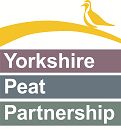I am from Hawes in the Yorkshire Dales, yet until the other day I had little idea what devastation laid on my doorstep.
It was a Tuesday morning and I had a date with Lyndon and Jenny of Yorkshire Peat Partnership (YPP) on Fleet Moss. It is an area of peatland which I have seen many times, being next to the road over to Wharfedale, but paid scant attention to.
It took me an hour to walk from town to the site. It was a typically dree day, by which I mean misty and grey.



